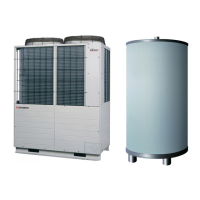
Do you have a question about the Mitsubishi Heavy Industries ESA30EH-25 and is the answer not in the manual?
| Brand | Mitsubishi Heavy Industries |
|---|---|
| Model | ESA30EH-25 |
| Category | Heat Pump |
| Language | English |
General safety guidelines and warnings for proper operation and preventing harm.
Important safety measures and recommendations for installing the unit correctly.
Advisories on avoiding combustible substances, cleaning, and abnormal situations.
Guidance on suitable environments and restrictions for unit operation.
Safety advice for moving, disassembling, or repairing the unit.
Instructions for proper disposal of electrical and electronic equipment.
Guide to periodic checks and estimated replacement times for unit components.
Specifies acceptable limits for various water quality parameters to prevent unit issues.
Explains the parts of the unit and how it heats water using CO2 refrigerant.
Highlights the environmental benefits and efficiency of using CO2 as a refrigerant.
Details how to set hot water temperature, amount, and schedule for optimal storage.
Explains the automatic and manual modes for space heating temperature control.
Defines how to prioritize hot water production over heating or vice versa.
Lists controllable settings like Run, Pause, Schedule, and Peak-cut with reference pages.
Identifies and explains the functions of the R/C's LCD screen and operational buttons.
Describes the main screen elements including clock, icons, menu, and message display.
Explains the components of the HW TOP screen, including clock, icons, and buttons for temperature/amount.
Details the elements of the Heating TOP screen, showing heating status and temperature settings.
Illustrates how to switch between different operational screens like TOP, HW, and Heating.
Guides on operating the unit for hot water production using temperature and amount settings.
Explains how to operate the unit for space heating using temperature and mode settings.
Instructions on using the Run/Pause switch to start or pause the unit's operation.
Details the steps to navigate to the HW TOP screen or Heating TOP screen from the main TOP screen.
Guides on setting the desired hot water temperature for the top-up operation.
Explains how to turn the heating operation ON or OFF using the remote control.
Instructions on setting heating temperature in AUTO or MANUAL mode and shift temperature.
Introduces setting weekly schedules, day off, and peak-cut timers for operation.
Details how to set daily hot water amounts or heating modes/temperatures for the week.
Guides on setting specific hot water amounts for different time slots throughout the week.
Details how to set heating modes and temperatures for specific times weekly.
Explains how to check and confirm the set weekly schedules for HW and heating.
Instructions on setting specific days or periods when the unit should not operate.
Guides on setting time periods and percentage for peak-cut to reduce power consumption.
Instructions on manually starting and ending the hot water fill-up process.
Allows adjusting the scheduled HW amount by a factor (More/Less) uniformly across days.
Shows how to view current/past hot water amounts and the unit's operating mode.
Lists settings that cannot be performed using a sub remote control.
Explains how to access and navigate through the main menu and its sub-menus.
Provides crucial information on returning, invalid operations, and timeouts during settings.
Overview of initial setup options including clock, date, contrast, backlight, sound, priority, and summer time.
Details how to access administrator settings, requiring a password for changes.
Allows enabling or prohibiting specific operations like Run/Pause or heating settings.
Guides on choosing which heat pump unit's status to display on the remote control.
Allows customizing which information (RC name, HP unit name, defrost status) is shown on the remote control.
Allows adjustment of the increment/decrement step for hot water temperature settings.
Provides instructions on how to change the administrator password for security.
Enables selection of predefined operation patterns based on business types for easier setup.
Allows changing the color or timing of the operation status lamp.
Defines the maximum allowable hot water storage temperature.
Guides on viewing the temperature detected by the open tank sensor.
Allows switching the unit's application between HW, Heating, or HW&Heating.
Provides an option to disable the weekly schedule for hot water when controlled externally.
Displays a list of all current settings for the remote control and connected heat pump units.
Instructions for cleaning and maintaining the remote control's LCD and body.
Guidance on ensuring proper air circulation and cleaning the heat exchanger and water circuit.
Refers to the specific instruction manual for maintaining the hot water storage unit.
Refers to component-specific manuals for maintaining space heating parts.
Advises on preventing pipe freezing and keeping the unit powered during cold weather.
Steps for shutting down the unit for over a month, including draining and power disconnection.
Guidelines for managing the unit during and after a power outage to prevent freezing.
Lists situations that might appear as errors but are normal unit behaviors.
Provides a comprehensive list of error codes, LED indicators, and corresponding inspection details.
Continues the error code list and introduces maintenance codes for service alerts.
Guides on how to find contact information for service and support through the menu.
Explains how the unit indicates when the next service date is approaching or has passed.
Informs about displays indicating required periodical inspections for water or refrigerant circuits.
Explains the meaning of the [In backup operation] message and the need for immediate inspection.
Provides guidance on contacting dealers for information, moving, repairs, and general after-sales support.
Instructions on how to select the desired display language for the remote control interface.
Guides on viewing the operational status, data, and sensor readings for connected units.
Lists detailed technical data including heating capacity, power consumption, dimensions, and electrical ratings.
